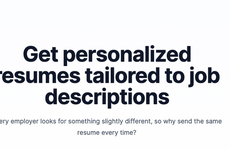
Sifting Through Genetic Resumes for the Best Employees
bunbunnyny — January 31, 2009 — Lifestyle
References: ornl.gov
The preeminent research work of the Human Genome Project has managed to receive both acclaim and criticism from the global scientific audience.
While the main purpose of the project’s establishment was to better understand the genetic makeup of the human species and our genetically inherited diseases, the outcome of this international scientific research can come to benefit future recruiters as well.
Through further investigation of what makes each individual genetically unique and/or similar, the discoveries made can help recruiters see the advantages and disadvantages that one job candidate has over another.
This ‘genetic resume’ will contain each candidate’s list of personality traits, working or learning habits and their susceptibility for illnesses or inherent diseases, which will help determine how many days that person may have to take off work due to those illnesses. Emerging companies such as Arbita are one of the first to be involved in researching this method of recruitment.
With the implementation of genome-based recruitment, future job candidates will no longer have the ability to over-embellish their resumes by claiming to be more experienced than they are, since all claims can be scientifically proven or disproven by the employers themselves.
The emergence of the genome recruitment method will hopefully do more to level the playing field of the workforce, help employers and recruiters to find the hidden gems and give them a chance to truly shine.
While the main purpose of the project’s establishment was to better understand the genetic makeup of the human species and our genetically inherited diseases, the outcome of this international scientific research can come to benefit future recruiters as well.
Through further investigation of what makes each individual genetically unique and/or similar, the discoveries made can help recruiters see the advantages and disadvantages that one job candidate has over another.
This ‘genetic resume’ will contain each candidate’s list of personality traits, working or learning habits and their susceptibility for illnesses or inherent diseases, which will help determine how many days that person may have to take off work due to those illnesses. Emerging companies such as Arbita are one of the first to be involved in researching this method of recruitment.
With the implementation of genome-based recruitment, future job candidates will no longer have the ability to over-embellish their resumes by claiming to be more experienced than they are, since all claims can be scientifically proven or disproven by the employers themselves.
The emergence of the genome recruitment method will hopefully do more to level the playing field of the workforce, help employers and recruiters to find the hidden gems and give them a chance to truly shine.
Trend Themes
1. Genome-based Recruitment - Disruptive innovation opportunity: Companies can use genetic information to accurately assess candidates' potential and make more informed hiring decisions.
2. Genetic Resumes - Disruptive innovation opportunity: Candidates can provide employers with a comprehensive overview of their genetic attributes, including personality traits and disease susceptibilities.
3. Leveling the Workforce - Disruptive innovation opportunity: The genome recruitment method can help create a fairer job market by eliminating resume embellishments and allowing employers to focus on true talent.
Industry Implications
1. Human Resources - Disruptive innovation opportunity: HR departments can integrate genetic information into their recruitment processes to improve candidate assessment.
2. Biotechnology - Disruptive innovation opportunity: Biotech companies can develop technologies and solutions to analyze and interpret genetic data for recruitment purposes.
3. Tech Startups - Disruptive innovation opportunity: Startups can enter the market by creating platforms or software that facilitate the collection, analysis, and visualization of genetic information for recruitment.
4.2
Score
Popularity
Activity
Freshness























